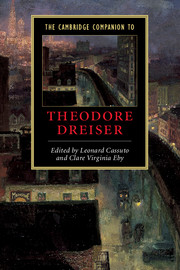Book contents
- Frontmatter
- Introduction
- Part I Backgrounds and contexts
- Part II Dreiser and his culture
- 5 The matter of Dreiser’s modernity
- 6 Dreiser, class, and the home
- 7 Can there be loyalty in The Financier? Dreiser and upward mobility
- 8 Dreiser, art, and the museum
- 9 Dreiser and women
- 10 Sister Carrie, race, and the World’s Columbian Exposition
- 11 Dreiser’s sociological vision
- 12 Dreiser and crime
- Select bibliography
- Index
10 - Sister Carrie, race, and the World’s Columbian Exposition
from Part II - Dreiser and his culture
Published online by Cambridge University Press: 28 May 2006
- Frontmatter
- Introduction
- Part I Backgrounds and contexts
- Part II Dreiser and his culture
- 5 The matter of Dreiser’s modernity
- 6 Dreiser, class, and the home
- 7 Can there be loyalty in The Financier? Dreiser and upward mobility
- 8 Dreiser, art, and the museum
- 9 Dreiser and women
- 10 Sister Carrie, race, and the World’s Columbian Exposition
- 11 Dreiser’s sociological vision
- 12 Dreiser and crime
- Select bibliography
- Index
Summary
In July 1893, as a correspondent for the St. Louis Republic, Theodore Dreiser accompanied a group of young female schoolteachers to the World’s Columbian Exposition. Commemorating the four hundredth anniversary of Columbus’s arrival in the New World, the Exposition, or World’s Fair, was held on a 686-acre site in Jackson Park, seven miles south of downtown Chicago, between May and October 1893. Visited by around twenty million people, it served to express dominant ideas about American and global cultures. Exhibits were divided into two separate sections: the White City, a collection of neoclassically fronted buildings containing the “best” of contemporary art and technology, displayed an official version of “progress” and the limitless possibilities for material and spiritual improvement opened up by the emergence of the United States as a world power. The Midway Plaisance, a mile-long strip that led up to White City, combined popular amusements, such as the Ferris wheel, with ethnological displays of other, explicitly “primitive,” cultures.
Dreiser was fulsome in his praise for what he witnessed in the official section of the Fair. He enthused:
The White City is grand. It is beautiful by day, with the blue sky above, the changing colors of the waters of Michigan to the east of it and the glorious sunbeams flooding its arches and spires, its pillars and domes, as they stand so distinct and clear, out against the sky … Then it is that one is reminded of what the ancient Athenian capital must have been like. How its temples and public buildings, its statuary and its public ways must have adorned the ancient hills of Hellas. One can understand, looking at the group of buildings so gracefully sweeping away on every hand, why the Grecians were proud and how it came that men could meditate the sublime philosophies that characterized that mythic age.
- Type
- Chapter
- Information
- The Cambridge Companion to Theodore Dreiser , pp. 160 - 176Publisher: Cambridge University PressPrint publication year: 2004
- 1
- Cited by



